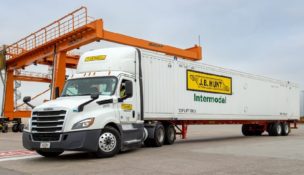By Marc Barnes, Special to Furniture Today
HIGH POINT — Today, somewhere, a Kenworth W990 towing a 53-foot trailer loaded down with case goods will accelerate down an entrance ramp onto an interstate highway, bound for a furniture warehouse.
In a lane going in the opposite direction, a box truck with a furniture retailer’s logo in a vinyl wrap is headed to a customer’s home.
Maybe in a city down on the coast, rolls of fabric or furniture components are being offloaded in containers from ships onto trucks, bound for furniture factories in North Carolina or Mississippi or California or Texas.
It’s logistics, and it’s in motion in more ways than one. Consolidations and bankruptcies are going on throughout the industry, including the notable loss a month ago of Yellow Corp., a 99-year-old company which specialized in “less-than-truckload” shipping. In all, 30,000 employees were let go in a move that sent reverberations throughout the industry.
Combine that with the continuing effects of unprecedented demand during the pandemic, followed by an almost complete stop in business as lockdowns ended; to the continuing economic uncertainties of inflation, high unemployment and high mortgage rates; to shortages in available employees.
A spot check with several veterans within the furniture logistics segment provides some insight on how the segment is faring and the outlook for this year and beyond.
Investing in future
At Massood Logistics, CEO Edward Massood said he is not worried about the long-term future, but rather he is concerned about what’s just around the corner.

“Home furnishings live on putting down deposits, and I am concerned for the retailers,” said Massood. “Whether they are over inventoried and not moving as quickly, it doesn’t generate cash. and they have already spent the money. Short term, it is going to be a little tight.”
Similarly, transport companies built operations based on a certain volume level, and now that it has slowed, panic is starting to set in.
“What affects one affects all,” said Massood.
What’s needed, right now, is the ability and willingness to make wholesale changes.
“You do not make changes when you are at full throttle, like most of us have since 2020. In 2021 and 2022, we were going full throttle at 100 mph,” said Massood. “Now is when you stop and reflect on what you did well and what could have gone better.”
Along those lines, Massood said he is investing in automation inside the warehouse. Buying more lifts, clamp trucks, order pickers and forklifts effectively lightens the load, while at the same time, both offsetting the labor shortage and helping convince people to come to work for the company.
In a similar way, retailers can look at their own operations.
“A lot of smart ones are figuring it out that they don’t have to have as many collections, they are figuring out having the right producers and having the right flow of product,” said Massood. “They have the right goods and suppliers, and they are able to get back to a normal production cycle of from six or eight weeks.”
Wait and see

Anthony Brooks, president and CEO of Brooks Furniture Express, which owns Shelba D. Johnson Trucking and MFX, said his company is taking a wait-and-see approach, given that his customers are telling him that although sales are down, they’re still better than 2019.
“Until interest rates for mortgages drop back to the 3% to 5% range, we project the economy will stay status quo overall,” said Brooks. “While some companies may exceed their projections, others may see flat or declining revenues.”
Despite the uncertainty in the marketplace, Brooks Furniture Express has a plan.
“Our model is to continue to do what we do and do it well,” said Brooks. “If we stay the course and offer industry best delivery times, exceptional customer service and continue to operate at a level above the rest, we anticipate stable growth.
“But at the end of the day, it all depends on the consumers. If they continue to buy furniture, then we will all have product to deliver. If consumer spending slows down, then it could be trouble for companies that had not prepared for the downturn.”
The company has capitalized on the slowdown by adding 10 more states to its delivery area over the past two months.
“We are working daily to increase business to those new states and have already seen exponential growth over our projections,” said Brooks. “That will continue to be our focus now and into early 2024. We’ve been approached many times to add those states to our delivery area. With the downturn in the economy, the abundance of drivers and capacity it was the perfect time to increase our delivery area to help offset the slowdowns we saw last quarter.”
Challenging position

Julian Ludlow, president of FragilePak, said that the multitude of challenges, from high demand to slow-moving supply and high cost of ocean-bound freight, coupled with a soft economy have put companies in a challenging position.
“Companies will need to adjust their inventory and rebalance to the current demand during this uncertain economic time,” said Ludlow. “There is still consumer spending today, but some merchandise is softer than what we experienced during the past two years. There is a correction in spending in furniture and other consumables.”
One continuing area of concern is the driver shortage, which Ludlow says logistics companies need to continue to focus on to find long-term solutions. Right now, he said, the shortage seems to have eased up somewhat because of the softness in the marketplace, the current capacity that is available and the unfortunate issues with Yellow Corp.
Otherwise, the economy seems to be getting back into the seasonal rhythms it had in 2019 and the years before COVID. Ludlow says that he is hoping for a strong holiday season in advance of a better 2024.
In the meantime, FragilePak will streamline its operations and costs; further develop its client base and focus on the driver shortage, to meet the needs of customers who have less volume.
“In the short term, we need to be cost conscious and manage to the business levels we have today,” said Ludlow. “Our customers need business partners who can be nimble during these economic times that we find ourselves in. We are focused on being a brand extension of our customers ensuring we execute on the service expectations while dazzling the buying customer with legendary service.”





